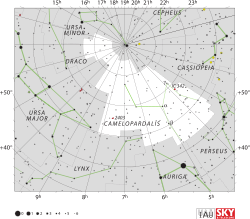Camelopardalis
| Constellation | |

|
|
| Abbreviation | Cam |
|---|---|
| Genitive | Camelopardalis |
| Pronunciation | /kəˌmɛləˈpɑːrdəlᵻs/, genitive the same |
| Symbolism | Giraffe |
| Right ascension | 03h 15m 36.2232s–14h 27m 07.8855s |
| Declination | 86.0975418°–52.6655540° |
| Family | Ursa Major |
| Area | 757 sq. deg. (18th) |
| Main stars | 2, 8 |
|
Bayer/Flamsteed stars |
36 |
| Stars with planets | 4 |
| Stars brighter than 3.00m | 0 |
| Stars within 10.00 pc (32.62 ly) | 3 |
| Brightest star | β Cam (4.03m) |
| Nearest star |
LHS 2459 (17.58 ly, 5.39 pc) |
| Messier objects | 0 |
| Meteor showers | October Camelopardalids |
| Bordering constellations |
Draco Ursa Minor Cepheus Cassiopeia Perseus Auriga Lynx Ursa Major |
|
Visible at latitudes between +90° and −10°. Best visible at 21:00 (9 p.m.) during the month of February. |
|
Camelopardalis /kəˌmɛləˈpɑːrdəlᵻs/ or the Giraffe constellation is a large, faint grouping of stars in the northern sky. The constellation was introduced in 1612 (or 1613) by Petrus Plancius. Some older astronomy books give an alternative spelling of the name, Camelopardalus, Camelopardi as well as Camelopardus.
First attested in English in 1785, the word camelopardalis comes from Latin, and it is the romanization of the Greek "καμηλοπάρδαλις" meaning "giraffe", from "κάμηλος" (kamēlos), "camel" + "πάρδαλις" (pardalis), "leopard", due to its having a long neck like a camel and spots like a leopard.
Although Camelopardalis is the 18th largest constellation, it is not a particularly bright constellation, as the brightest stars are only of fourth magnitude. In fact, it only contains four stars below magnitude 5.0.
Other variable stars are U Camelopardalis, VZ Camelopardalis, and Mira variables T Camelopardalis, X Camelopardalis, and R Camelopardalis.RU Camelopardalis is one of the brighter Type II Cepheids visible in the night sky.
...
Wikipedia
